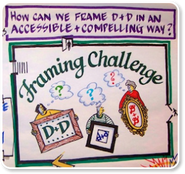 This article by NCDD Co-Founder Sandy Heierbacher was published in the September 2009 edition of the International Journal of Public Participation (IJP2). You can download the full .doc article here. The article outlines NCDD’s learnings in two of the five challenges we focused on at the 2008 NCDD conference in Austin:
Abstract. At the National Conference on Dialogue and Deliberation (NCDD) in Austin, Texas in October 2008, conference organizers ran a unique multi-tiered process aimed at helping attendees focus on five major challenges facing the dialogue and deliberation community. The five issues were identified by participants at previous National Coalition for Dialogue and Deliberation conferences as vital to address if we, individually and collectively, are to be our most effective. This article outlines the discourse in our community of practice on two of the five challenges: the “Systems Challenge,” which focuses on making dialogue and deliberation integral in our government and other systems, and the “Framing Challenge,” which is concerned with how we can talk about and present public engagement work in ways that are accessible and compelling to the greatest possible audience. Here’s a quick summary of the segments on the Framing Challenge: 1. Develop a common language of practice with more universal appeal Can we identify common yet compelling language that represents the work we do in dialogue and deliberation? Can we get clear on our theories of change? 2. Consider how different framings affect different groups Some terms we use in this field turn people away because they are too “new-agey” sounding; others because they are too academic or jargony, or because they have negative connotations or implications for certain audiences. Practitioners are acquiring and cultivating greater sensitivity to the ways that distinct language ‘plays out’ for different groups. 3. Understand the specific concerns of conservatives Progressives seem to be more drawn to public engagement work than conservatives. Understanding and acknowledging conservatives’ concerns about this work is key. 4. Frame in terms of general goals and desired outcomes While no single framing works for all audiences, practitioners are finding success in focusing on the purpose or potential outcomes (in general) of engagement rather than focusing on process. 5. Cultivate the ability to adapt framings for different audiences How practitioners should emphasize potential action outcomes depends, in part, on who they are trying to reach. We must use language to which people from potentially underrepresented groups can relate, while remaining open and honest about the purpose of the program. Keywords: dialogue, deliberation, public engagement, framing, systems, embeddedness, practitioner Citation: Heierbacher, Sandy. (2009). Taking our work to the next level: Addressing challenges facing the dialogue and deliberation community. International Journal of Public Participation, 3(1), 108-131.
0 Comments
|
Categories
All
|
Follow Us
ABOUT NCDD
NCDD is a community and coalition of individuals and organizations who bring people together to discuss, decide and collaborate on today's toughest issues.
© The National Coalition For Dialogue And Deliberation, Inc. All rights reserved.
© The National Coalition For Dialogue And Deliberation, Inc. All rights reserved.

 RSS Feed
RSS Feed